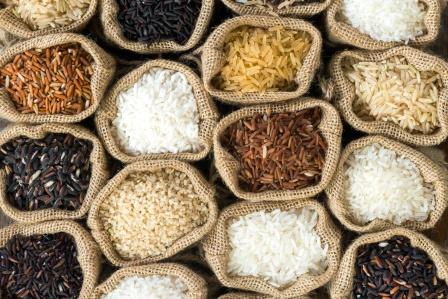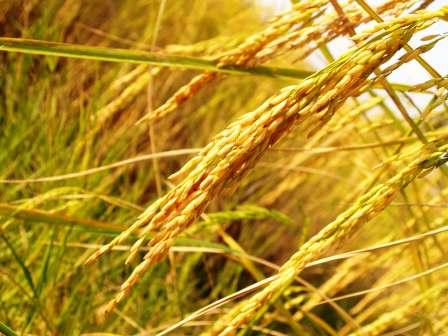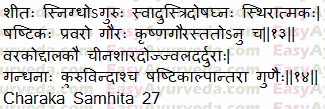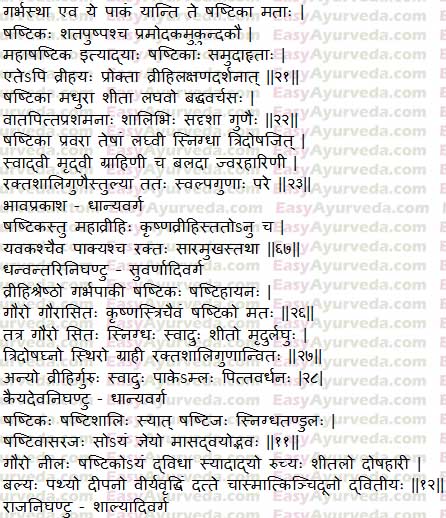Navara Rice (Shashtika Shali) Qualities, Uses, Remedies, Research

By Dr Renita D’Souza
Ayurveda science mentions about Shastika Shali (Oryza sativa) a variety of rice well known for its medicinal properties. It is harvested in 60 days. Shastika in Sanskrit indicates the number 60 and Shali means rice.
Table of Contents
Njavara – Introduction, traditional use
It is widely used in Panchakarma therapy Shastika shali Pinda sweda, an effective treatment for neuromuscular disorders.
Read – Njavarakizhi: Shashtika Shali Pinda Sweda Benefits

Traditional Uses of Navara
It is used to treat fever, neurological disorders, circulatory disorders, digestive problems, respiratory problems etc. Consumption of Navara rice gruel is beneficial in psoriasis, liver cirrhosis and piles.
How to identify Navara rice?
It is very hard to guess which variety is actually navara.
Master Charaka says Rakta Shali is good.
So, any rice, which has natural red colour, which is grown as organically as possible, grown locally, if possible, without excessive use of chemicals, upon consuming which, you do not feel excessively Guru – heaviness, you feel light and feel the body channels opening up, is a healthy variety of rice to use.
Botanical Name – Oryza sativa
Family – Gramineae
Traditional remedies
Traditional Remedies of Shashtika Rice (A)
- Cooked shashtika rice is beneficial for infants with low weight.
- It is also a good weaning food.
- Diet for Pregnant women – Broth prepared with shashtika rice and meat is beneficial to increase the weight of fetus.
- Internal wounds – Shastika shali is cooked with milk and medicinal herbs.
- Shastika rice bran oil – It is the oil obtained from rice husk is used to relieve pain such as arthritis, cervical spondylosis, Low back pain, paralysis etc.
- Psoriasis – Shastika shali rice paste is applied externally
- Shastika rice gruel is good for diabetic patients and prevents various diseases.
- Fatigue – Shastika rice boiled in Bala (Sida cordifolia) decoction added with milk is used as replenishing drink. This drink is called karkidakakanji.
- Ulcers
Peptic ulcers – Intake of shastika bran with jaggery is beneficial.
Mouth ulcer – Consumption of Navara rice bran in boiled milk - Snake Bite – Navara rice powder paste is used to cure pain and heal wound in snake bite.
- Urinary Tract Infection – Drinking water boiled with Navara root is beneficial in UTI and acts as diuretic.
Read – Rice Combinations With Pulses, Vegetables, Grains, Soups
Sanskrit Verse, Qualities,

Qualities of Shashtika shali
Taste – sweet
Laghu – light to digest
Snigdha – unctuous
Mrudu – soft
Grahi – absorbent
Badda Varchas – constipating
Balada – promotes strength
Jwarahara – cures Fever
Sthira – stabilizing
Pathya – wholesome
Ruchya – improves taste
Deepana – kindles digestive fire
Virya vrddi – increases vigor and vitality
Qualities of Shashtika shali are slightly inferior than the qualities of red variety of rice (Raktha Shali) which is considered to be the best.
Effect of Shashtika shali on Tridoshas
Tridoshagna – Balances all three doshas, Vata, Pitta and Kapha
Read – Rice Water (Tandulodaka) Ayurvedic Preparation Method, Uses

Varieties of Shastika Shali

Reference – Charaka Samhitha Sutrasthana 27/13
1. Varaka
2. Uddalaka
3. Cheena
4. Shaarada
5. Ujwala
6. Dardura
7. Gandhana
8. Kuruvinda
These are slightly inferior in quality when compared to Shashtika.
White variety of shastika shali is good and blackish white variety is slightly inferior in quality.
Read – Ayurveda Mahodadhi Dhanya Varga – Types Of Rice
Reference – Bhavaprakasha Nighantu
1. Shastika
2. Shatapushpa
3. Pramodaka
4. Mukundaka
5. Mahashastika
These varieties can also be called as Vreehi because their qualities resembles to that of Vreehi. Vreehi is the variety of rice that matures in rainy season.
Properties of shastika shali as per Bhojana Kutuhalam
As per Bhojana Kutuhala first chapter, Shastika shali is of white and black variety. The former one imparts taste, is cold in potency and cures afflictions of doshas, it is strengthening and wholesome in quality, it stimulates the digestive fire and helps to promote virility. the later one is of inferior quality compared to the former one.
Navara Vs other rice varieties
23. Which type of rice is best for daily use?
Dr JV Hebbar:
There is a type of rice explained in Ayurveda, called Shashtika Shali. The one which is harvested in sixty days. This is considered as the best quality of rice. It is recommended to be used on a daily basis.
Some companies market a type of rice called as Navara Rice, which is purported as the Shashtika Shali rice. Very costly though.
It is also told that red variety of rice – Rakta shali is the best. If you can get Navara rice, it is good. Or any locally grown red variety of rice is still very good to use. No big reason to run behind the very costly navara rice.
Or even if that is not available, locally grown white rice, (if possible, unpolished) is very fine to use.
Read: Rice Combinations With Pulses, Vegetables, Grains, Soups
Brown rice has become a fad these days, which is nothing but the de-husked unpolished rice. Which is also very good to use, considering that it contains some amount of fiber content in it and thus, contains less amount of calories and has low glycemic index. It is better than polished white rice for people with diabetes.
Morphology, Distribution, Research
Morphology of Oryza sativa
Oryza sativa is an erect, annual grass growing up to 50 – 150 cm tall. Stem erect, smooth, hairless and hollow. Leaves 15-30 cm long with ligule and auricle. Inflorescence is a terminal panicle. Rice grain is oblong in shape.
Distribution of Shastika shali
Shastika rice is found in Kerala.
Research on Sastika Shali
A research article on sustainable value of Navara rice in medicinal and aesthetic aspects mentions about anti- carcinogenic property of navara rice. (read)
Vernacular names, Classification
Names in different Languages
English Name – Rice, paddy
Hindi Name – Chaval, Dhana
Marathi Name – Tadula, Bhata
Kannada Name – Matta
Malayalam Name – Navara
Gujarati Name – Bhata, Chorva
Bengali Name – Dhana, Chaval
Tamil Name – Arshi, Nellu
Telugu Name – Dhanyasu, Odalu
Spanish Name – Arroz
French Name – Riz
Portuguese Name – arroz comum
Germany Name – Reis
Bangladesh Name- bhat
Cambodia Name – sröw
Indonesia – padi
Italy – riso comune
Japan – kome
Malaysia – padi
Myanmar – sabar-bin
Netherlands – rijst, rice
Philippines – palay
Sweden – ris, vanlig
Thailand – khao
Vietnam – lúa
Read – Quality Of Foods – Astanga Hridaya Sutrasthana 6 – Annaswaroopa
Classical categorization
Bhavaprakasha Nighantu – Dhanya Varga
Dhanvantari Nighantu – Suvarnaadi Varga
Kaiyadeva Nighantu – Dhanya Varga
Raja Nighantu – Shalyadi Varga
Scientific Classification
Domain – Eukaryota
Kingdom – Plantae
Phylum – Spermatophyta
Subphylum – Angiospermae
Class – Monocotyledonae
Order – Cyperales
Family – Poaceae
Genus – Oryza
Species – Oryza sativa
Click to Consult Dr Renita D’Souza
Interaction with medicines, supplements
Can this be used while taking Homeopathic medicine?
Yes. This product does not react with homeopathic medicine.
Can
this medicine be continued while taking supplements like multivitamin tablets,
Omega 3 fatty acids etc?
Yes. Generally, this product goes well with most
of the dietary supplements. However, if you are taking more than one product
per day, please consult your doctor for an opinion.
With western
medicines
Seek your
doctor’s advice if you are taking this product along with other western
(allopathic / modern) medicines. Some Ayurvedic herbs can interact with modern
medicine.
If both Ayurvedic and allopathic medicines are advised together, then it is
best to take Allopathic medicine first, wait for 30 minutes and then take the
Ayurvedic medicine.











4 comments
Jesse
I’m dutch. Rice means rice. gewoone means “normal” but it is misspelled as it should be “gewone”. However I don’t see any reason to even use the word. Normal rice… what does that mean? Normal wheat :P?
Just correcting here. No disrespect.
Dr J V Hebbar MD(Ayu)Author
Duh! That was a silly mistake. Thanks for correcting.
Omkar
Dear team,
Can we get the exact recipe about the karkidaka kanji and it’s step by step preparation also it’s effects and applications?
Thank you
Dr J V Hebbar MD(Ayu)Author
Will write shortly.